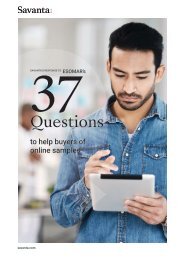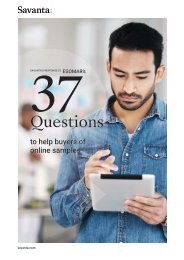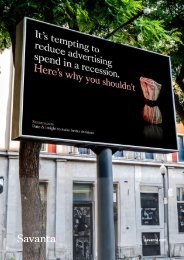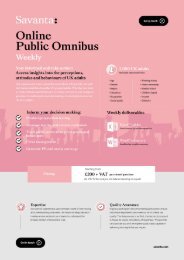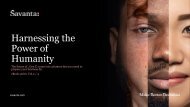Savanta DEI report 2023 v0
Create successful ePaper yourself
Turn your PDF publications into a flip-book with our unique Google optimized e-Paper software.
INVESTIGATING INTERSECTIONALITY<br />
Understanding bias,<br />
discrimination, and<br />
its impact on society<br />
savanta.com<br />
Make Better Decisions
DIVERSITY, EQUITY, AND INCLUSION REPORT <strong>2023</strong><br />
Contents<br />
INTRODUCTION<br />
SETTING THE SCENE<br />
RACISM AND RESPONSIBILITY<br />
EMPLOYMENT AND EQUITY<br />
EXPERIENCE AND BEHAVIOR<br />
WHO WE SPOKE TO<br />
3<br />
4<br />
8<br />
12<br />
20<br />
25<br />
// 2
DIVERSITY, EQUITY, AND INCLUSION REPORT <strong>2023</strong><br />
Everything is connected<br />
Society is slowly waking up to the bias and discrimination<br />
that infiltrates the day-to-day lives of those from diverse<br />
communities. The more we observe the world around us, the<br />
more we see the connections and shared experiences of<br />
those from different and overlapping under-represented<br />
groups. Many voices are louder than one, and from<br />
ethnicity to sexuality and gender to religion, different<br />
groups are banding together to make themselves heard,<br />
increase awareness of the issues they face every<br />
day, and drive change, to build a more equitable and<br />
inclusive society.<br />
Building on our previous <strong>report</strong>s, which started after the death<br />
of George Floyd, in this <strong>2023</strong> <strong>report</strong>, we are investigating the<br />
experiences of people across the US and Europe, with a<br />
focus on under-represented groups and their involvement in<br />
society and workplace culture, centering on intersectionality<br />
at the core of this <strong>report</strong>’s shift.<br />
This <strong>report</strong> investigates the views and lived experiences<br />
of 4,973 people from the United States, United<br />
Kingdom, France, Sweden, Germany, and the<br />
Netherlands to identify where the issues lie, how they<br />
impact behavior, and what progress is being made<br />
to increase diversity, equity, and inclusion. Data<br />
based on the BIPOC community stems from the<br />
UK and US only.<br />
<strong>Savanta</strong>’s role<br />
<strong>Savanta</strong> regularly conducts research on key issues and how they impact<br />
people and the world around us. Using our strengths in research and data<br />
collection, we wanted to create a study on intersectionality – the interconnected<br />
nature of social categorizations – to gauge how experiences vary between underrepresented<br />
groups.<br />
Through our data, we want to highlight the impact that existing social structures<br />
and conventions have on different communities and how they might affect<br />
opportunities, attitudes, and behavior. We want to make sure that everyone feels<br />
heard, and identify some of the barriers people face so that, as a society, we can<br />
start to remove them.<br />
Sadia Corey<br />
VP | Client Development<br />
// 3
DIVERSITY, EQUITY, AND INCLUSION REPORT <strong>2023</strong><br />
Where do people experience<br />
discrimination?<br />
Education<br />
Healthcare<br />
Financial services<br />
Law enforcement<br />
The education system is supposed to<br />
give us the building blocks we need to be<br />
functional members of society, but 24%<br />
say they have experienced discrimination.<br />
Discrimination in education can hold<br />
people back from achieving their potential<br />
and leave them at a disadvantage.<br />
Prevalence was particularly high in the<br />
Muslim community (51%), and in the<br />
BIPOC communities across the UK and US<br />
(41%). A particularly concerning statistic<br />
given the Supreme Court’s recent decision<br />
to strike down the affirmative action<br />
policies at Harvard and North Carolina.<br />
25+25+25+25=<br />
One in four<br />
people personally<br />
experienced<br />
discrimination when<br />
they were in the<br />
education system<br />
Access to healthcare is critical for making<br />
us feel safe within our communities, but<br />
22% of those surveyed said they had met<br />
with problems.<br />
Those in the LGBTQIA+ community are<br />
again more likely to have had issues<br />
(32%), with 47% of those identifying as<br />
transgender, non-binary, or genderqueer<br />
experiencing some form of discrimination<br />
when it came to accessing healthcare.<br />
One in five<br />
people have had<br />
difficulty accessing<br />
quality healthcare<br />
Approximately one in five people have<br />
experienced discrimination when it comes<br />
to their personal finances – particularly<br />
when it comes to borrowing money, such as<br />
taking out a loan or mortgage. Being locked<br />
out of credit limits the possibility of home<br />
or car ownership and even the opportunity<br />
to start a business. This increases to 30%<br />
within the LGBTQIA+ community.<br />
An even stronger stance can be said for<br />
religious groups; An increased perception of<br />
financial service difficulty based on forms<br />
of discrimination for individuals who identify<br />
as Muslim (43%), spiritual people (37%),<br />
and other non-Christian religious groups.<br />
Evidently, discriminatory patterns when it<br />
comes to personal finances means curbing<br />
the ability to build generational wealth for<br />
entire groups of marginalized folks.<br />
Nearly one in four people believe they<br />
have been stopped by security or police<br />
unprovoked as a result of their ethnicity,<br />
sexuality, religion, or gender. With this<br />
experience, individuals have the potential<br />
to feel uncomfortable around those in the<br />
community who are there to protect them.<br />
This increases to nearly a third (32%) of<br />
those within the LGBTQIA+ community,<br />
and in the US, more than two in five (44%)<br />
amongst the BIPOC community.<br />
23+77+77+S<br />
23% have been<br />
stopped by law<br />
enforcement with no<br />
justification because<br />
of an aspect of their<br />
identity<br />
21% have had<br />
difficulty accessing<br />
financial services<br />
because of their<br />
identity<br />
// 4
DIVERSITY, EQUITY, AND INCLUSION REPORT <strong>2023</strong><br />
Where do people experience<br />
discrimination?<br />
OPINION:<br />
Tania Findlay, Associate Director<br />
Society is going through a lot of change at the moment – with the cost-of-living crisis, inflated<br />
energy bills/mortgage rates, and the war in Ukraine dominating the geopolitical climate, just to<br />
name a few; none of us can escape the uncertainty of the future.<br />
Adding an additional layer and looking at underrepresented groups, the world becomes even<br />
more worrying. Whether it comes to employment, or accessing essential services such as<br />
education or healthcare, at least 2 in 5 will face some form of discrimination.<br />
While positive steps are being taken, and we have moved on in recent years, we are still a<br />
long way from where we need to be, and it’s essential that we all make a positive contribution<br />
to remove the bias that people face. We should all be able to feel comfortable leaving the<br />
house, going to work, or going out for dinner without being maltreated because of our religion,<br />
sexuality, or skin color.<br />
Removing bias is just as crucial for future generations as climate change (for example), and<br />
just like climate change, it is one of the few social issues of today that we have some level of<br />
control over.<br />
To overcome biases, we must be more aware of their presence, reflect on their nature, and<br />
understand how those affect our thoughts, opinions, and actions. Once we bring those biases<br />
from our subconscious to the forefront, we can then commit ourselves to implementing<br />
practical strategies to counteract these biases and ultimately change our behavior.<br />
// 5
DIVERSITY, EQUITY, AND INCLUSION REPORT <strong>2023</strong><br />
Is the workplace a safe space?<br />
We spend around a third of our lives at work, and more<br />
companies are focusing on developing an inclusive culture<br />
where everyone is seen, heard, and respected. Despite<br />
their efforts, it seems that there is still a long way to go as<br />
discrimination in the workplace is still relatively common.<br />
Overall, 28% feel like they have been discriminated against while at work<br />
and with a similar number (29%) believing that they have been looked<br />
over for promotion, or simply not employed in the first place due to<br />
their identity. Despite this, two in three (66%) remain satisfied with their<br />
employer.<br />
However, discrimination appears significantly more prevalent amongst<br />
certain groups in the workplace in comparison to other areas of life.<br />
Three in five (61%) people who identify as trans, genderqueer, or<br />
non-binary have experienced workplace discrimination while nearly half<br />
(48%) believe they have been overlooked for a promotion or new role.<br />
Across the wider LGBTQIA+ community, 42% agree that they have faced<br />
workplace discrimination.<br />
QHave you experienced discrimination at<br />
work due to an aspect of your identity?<br />
UK //22 %<br />
FR //29 %<br />
US //33 %<br />
SE //32 %<br />
NL //25 %<br />
DE //25 %<br />
Religion is also an important factor, with half (50%) of those coming from<br />
non-Christian religions, such as Buddhism, Judaism, Islam, Hinduism,<br />
and East Asian folk religions, having experienced discrimination at<br />
work. From small things, like celebrating a mix of religious holidays, to<br />
larger issues like office bullying, business leaders should be aware and<br />
supportive of their teams’ religious needs.<br />
In the UK and US, 44% of people within the BIPOC community agree they<br />
have faced discrimination in the workplace, with 46% agreeing they have<br />
been passed over for promotion or not hired for a role due to an aspect<br />
of their identity.<br />
// 6
DIVERSITY, EQUITY, AND INCLUSION REPORT <strong>2023</strong><br />
We’re in this together<br />
With high inflation affecting economies globally, it is unsurprising that 71% of those<br />
surveyed have read or heard about the cost-of-living crisis, with nearly two-thirds<br />
(65%) ranking it as one of their top three most important social issues right now.<br />
In the UK, which is experiencing an uncomfortable combination of increasing base rates and high<br />
inflation, 84% have heard about it, and 82% rank it as one of the top three most important social issues<br />
to them.<br />
The current geopolitical climate is creating a stir, with war and conflict (57%) the second most popular<br />
topic of conversation. Countries closer to Ukraine are understandably more aware of or concerned<br />
about war than others, with 73% of those in Germany and 69% of those in the Netherlands having read<br />
about war and conflict recently.<br />
While these are all issues affecting consumers on a global scale, many countries have their own issues<br />
to worry about. In France, more than half (52%) of consumers have read or heard about domestic<br />
violence recently against a global average of just 35%. The current discourse focuses on several<br />
well-known figures who have faced charges recently. The situation has been further exacerbated<br />
following the shooting of 17 year old Nahel Merzouk by French police.<br />
In Germany, 72% have heard or read about climate change recently, significantly above the global<br />
average of 55%, following policy deadlock and subsequent controversial reforms.<br />
QWhat are the top three most important<br />
social issues to consumers right now?<br />
Country spotlight: US<br />
In the US, political and ideological shifts have<br />
brought a number of issues to the top of the<br />
agenda. Gun control is the second most talked<br />
about social issue (65%), after the cost of living<br />
(67%), as it remains a highly contentious subject,<br />
pitting gun control advocates against those keen to<br />
protect their constitutional right to bear arms. Two<br />
in five (40%) rank it as one of their top three most<br />
important social issues.<br />
Since Roe v. Wade was overturned in 2022, there<br />
has been a spate of policy changes when it comes<br />
to abortion, with each state developing its own<br />
laws. With widespread debates about viability, time<br />
restrictions and parental safety, 62% of Americans<br />
have read or heard about abortion recently, and<br />
25% rank it as one of their top three social concerns<br />
currently.<br />
Cost of living or inflation War and conflict Climate change<br />
65 % 32 % 32 %<br />
// 7
DIVERSITY, EQUITY AND INCLUSION REPORT <strong>2023</strong><br />
RACISM<br />
& responsibility<br />
Despite the obvious power of the Black Lives Matter movement around the world,<br />
along with protests and efforts from governments and businesses to improve racial<br />
equity, this research suggests that we have not yet reached a tipping point when it<br />
comes to overcoming other societal drivers.<br />
More than half (53%) of the people surveyed agree that their country is divided along racial lines,<br />
increasing to 69% of people living in the United States. With politics, economics, and many other factors<br />
at play, it is important that everyone takes responsibility for closing the divide.<br />
In this section of the <strong>report</strong>, we look at racism against different communities, where primary<br />
responsibility for increasing equity and inclusion rests and the impact of the mainstream media on<br />
propagating both positive and negative views.<br />
// 8
DIVERSITY, EQUITY, AND INCLUSION REPORT <strong>2023</strong><br />
Is society becoming more racist?<br />
Civil rights and race certainly are not flying under the<br />
radar, with around a quarter (24%) of those surveyed<br />
having read or heard about this issue recently. Despite<br />
efforts around the world to raise awareness and<br />
address racism, the overwhelming majority of people<br />
believe that racism – towards those of any race – has<br />
either increased or stayed the same.<br />
QHow did racism towards each of the<br />
following groups change in the last year?<br />
Increase No change Decrease Not sure<br />
After the George Floyd tragedy triggered protests against police<br />
brutality around the world in 2020, many would have hoped that<br />
the steps organizations around the world have taken to overcome<br />
racism against black people would have started to make a<br />
difference. However, 41% of those surveyed agree that racism<br />
against black people has increased in the past 12<br />
months. In the US, 65% of black people agree that racism has<br />
increased, suggesting the lived experience may be different to the<br />
outside perception.<br />
It seems that racism against people from the Middle East and<br />
North Africa has also increased significantly in the last year.<br />
This is particularly true of France and Germany, where 60% and<br />
50% respectively, agree that racism against this community has<br />
increased, which could be as a result of people being displaced<br />
by regional conflict and making new homes in Western<br />
European countries.<br />
10 % 6 % 10 % 8 % 13 % 16 %<br />
13 % 18 % 12 % 16 % 13 % 12 %<br />
50 % 36 % 38 % 42 % 51 % 53 %<br />
27 % 41 % 40 % 34 % 23 % 18 %<br />
White / Caucasian<br />
Black Middle Eastern /<br />
North African<br />
Asian<br />
Indigenous<br />
/ US ONLY /<br />
Hawaiian or other<br />
Pacific Islander<br />
/ US ONLY /<br />
// 9
DIVERSITY, EQUITY, AND INCLUSION REPORT <strong>2023</strong><br />
Who is responsible for addressing racism?<br />
The consensus worldwide is that everyone has a role<br />
to play in tackling racism. Of those surveyed more<br />
than two-thirds (68%) agreed that everyone in their<br />
country is responsible, at least to some extent.<br />
Those in the UK were less likely to ascribe responsibility to any<br />
one organization or community, but 75% agreed that everyone<br />
should work together to address the problem of racism.<br />
Comparatively, those in Sweden were much less likely to put<br />
the responsibility on everyone than other countries in the survey<br />
(45%), with more people (49%) believing that the government<br />
should take control of the situation. Germany and France were<br />
also significantly more likely than average (57% and 51% versus<br />
37%) to look to the government to find and tackle racism in<br />
their countries.<br />
In the US, where law enforcement has been a focal point for the<br />
discussion around racism, a quarter (24%) agree that police<br />
and other enforcers should take responsibility, although this<br />
increases to 31% amongst people from black communities.<br />
Federal government<br />
35+65+M<br />
37 %<br />
Law enforcement<br />
25+75+M<br />
25 %<br />
Schools<br />
30+70+M<br />
15+85+M<br />
30 %<br />
White communities<br />
15 %<br />
Local government<br />
29 %<br />
29+71+M<br />
Industry leaders<br />
13+87+M<br />
13 %<br />
// 10
DIVERSITY, EQUITY, AND INCLUSION REPORT <strong>2023</strong><br />
Is mainstream media stoking the fire?<br />
The mainstream media, comprising national and regional newspapers, magazines,<br />
TV, movies, podcasts, radio broadcasts, and online publications, is becoming<br />
increasingly fragmented.<br />
With more channels and more publications, it is increasingly difficult to control and<br />
regulate against racist and other harmful content, particularly when trying to balance<br />
online safety with preserving freedom of speech.<br />
The role of algorithms<br />
Whatever consumers’ interests or beliefs, their experiences with online mainstream<br />
and social media are largely controlled by algorithms. Engagement with one piece of<br />
content will result in recommendations for other similar or linked content, which can<br />
result in people ‘going down a rabbit hole’ or being ‘trapped in an echo chamber’.<br />
While many organizations are working to reduce conscious and unconscious bias<br />
in their algorithms, and reduce potentially harmful content from their platforms, the<br />
volume of content means that companies often rely on AI or algorithms to identify<br />
dangerous or inappropriate content, and a lot flies under the radar.<br />
CASE STUDY:<br />
Media Matters for America<br />
Back in 2021, the not-for-profit research and information center<br />
Media Matters for America decided to study TikTok’s algorithm. After<br />
interacting solely with transphobic content, they quickly found that<br />
the recommendation algorithm populated the research account’s ‘For<br />
You’ page with misogynist, racist and white supremacist, antisemitic,<br />
ableist, and other violent or hateful content.<br />
Media Matters for America concluded: “In many videos containing<br />
harmful or violative content expressed more than one form of<br />
dangerous rhetoric… The intersectional nature of these videos means<br />
creators can incorporate various strains of bigotry and hate, and thus<br />
introduce viewers to new, dangerous ideologies.”<br />
53 %<br />
Of people feel that mainstream<br />
media has played an extremely<br />
or very significant role in<br />
perceptions of racism. In the<br />
US, this increases to 62%.<br />
4 %<br />
Agree that the media has played<br />
no role in perceptions of racism.<br />
OPINION:<br />
Kelsie Schroder, Research Manager<br />
As social media has become an integral part of our lives, it’s often<br />
debated how positive screen time is, how credible facts the media<br />
shares are, and the role the media plays in perpetuating negative<br />
perceptions of social issues. But as an avid social media user, I find<br />
power in gaining new perspectives and often learning something<br />
new from real people’s stories. There is no limit to growing our<br />
knowledge as humans, and social media serves as a more informal<br />
way of learning through others’ experiences and stories – opening<br />
me up from my physical bubble.<br />
// 11
DIVERSITY, EQUITY AND INCLUSION REPORT <strong>2023</strong><br />
EMPLOYMENT<br />
& equity<br />
The average worker spends around 20% of their week at work – but its impact on<br />
their lives is much further reaching. Work provides us with the income needed to<br />
have shelter, food, and safety, and it can also have a significant effect on confidence<br />
and overall happiness.<br />
As it stands, two in three (66%) employees are satisfied with their employer, but only 28% say they are<br />
very satisfied leaving room for improvement. As the data in this section shows, many workers feel<br />
discriminated against and there is scope for employers to provide more opportunities to generate<br />
equity for under-represented groups.<br />
The onus is increasingly on employers to do the right thing: to treat their employees well. While there is<br />
a balance to strike, less than half (46%) of employees agree that their employer cares about people over<br />
profit, which could negatively affect everyone in those workplaces, particularly those who are already<br />
vulnerable or disadvantaged.<br />
// 12
DIVERSITY, EQUITY, AND INCLUSION REPORT <strong>2023</strong><br />
What do employees expect from<br />
their employers?<br />
Employees want employers to pay most<br />
attention to their quality of life and<br />
experience in the workplace above<br />
anything else.<br />
Despite the current cost-of-living crisis affecting<br />
many countries, compensation and higher pay fall<br />
down the list of priorities that employees want<br />
their companies to focus on. Nearly twice the<br />
number of people would prefer their employer to<br />
focus on work-life balance, although it is more<br />
important to women (62% versus 54% of men),<br />
who typically pick up the lion’s share of household<br />
management and childcare duties.<br />
Women are also keener for their employers to<br />
focus on providing opportunities for growth and<br />
professional development (41% versus 32%)<br />
and on delivering diversity, equity, and inclusion<br />
initiatives (32% versus 24%).<br />
In addition to the top four priorities, employees<br />
would like to see employers focusing on<br />
creating hard-working environments (25%),<br />
on sustainability (25%), and on developing a<br />
professional work environment (22%).<br />
Regardless of their own values, employees put<br />
upholding values – traditional, progressive,<br />
patriotic or conservative – right at the bottom of<br />
the priorities they want their employer to focus on.<br />
59 %<br />
31 %<br />
Want their employer to focus on work-life balance<br />
Want competitive compensation, whether that is through salaries, bonuses, or other<br />
employee benefits<br />
37 %<br />
29 %<br />
Think their employer should focus on providing opportunities for growth and<br />
professional development<br />
Expect the employer to spearhead or support diversity, equity, and inclusion initiatives<br />
// 13
DIVERSITY, EQUITY, AND INCLUSION REPORT <strong>2023</strong><br />
Retention and workplace experiences<br />
Discrimination in the workplace can have an impact on employees’<br />
progression, financial security, confidence and sense of belonging, as<br />
well as their engagement with the workplace and productivity.<br />
With many employers focusing on removing any barriers and discrimination within<br />
their organization, nearly two in three (64%) employees have never felt discriminated<br />
against. Fewer than one in five (17%) agree that they have been discriminated against<br />
by their employer, although people in the US are more likely to agree that they have been<br />
discriminated against than those in Europe (23% versus 14%).<br />
While direct discrimination against workers may be improving, more than a quarter<br />
(27%) of those surveyed said they have previously left or are considering leaving a<br />
role because they do not feel comfortable expressing themselves or their views. This<br />
increases to 33% amongst the LGBTQIA+ community and 38% amongst those who are<br />
gender non-conforming. In the UK and US, 37% of those in the BIPOC community have<br />
also left a role, or are considering doing so in the near future, suggesting that many<br />
underrepresented groups may be having similar experiences.<br />
Gen-Z are more likely to agree that they have been discriminated against by an employer<br />
(21%), with over a third (35%) saying they have left or are considering leaving a role<br />
because they feel they cannot express their views, in comparison to only 13% of<br />
Boomers.<br />
I feel discriminated against by my employer:<br />
23 %<br />
21 %<br />
17 %<br />
17 %<br />
17 %<br />
Total<br />
BIPOC<br />
(UK and US<br />
only)<br />
LGBTQIA+<br />
Heterosexual<br />
White/<br />
Caucasian<br />
// 14
DIVERSITY, EQUITY, AND INCLUSION REPORT <strong>2023</strong><br />
What’s standing in the way of workplaces<br />
becoming more inclusive?<br />
As employees’ expectations – and those of society as a whole – continue to evolve, employers and business policies will need to evolve too. As<br />
younger generations join the workforce, it is becoming more transactional and people are prepared to move on from roles that do not meet their<br />
standards when it comes to inclusivity.<br />
Nearly two in five (38%) of those surveyed for this<br />
<strong>report</strong> agree that a truly inclusive and collaborative<br />
workplace will only be possible with a change of<br />
While companies are taking steps to improve<br />
representation in company leadership, it takes<br />
time for policies designed to increase the flow of<br />
Getting pay and promotion right is an essential<br />
factor in helping employees to feel appreciated, and<br />
ultimately to retain the best talent, but a significant<br />
business leadership. Boomers are less likely to agree<br />
talent to take effect. As it stands, 32% say that<br />
proportion of the workforce recognizes inequalities.<br />
29+31+30+25+37+34+31<br />
11+14+17+15+10+11+ (27%), and 37% strongly disagree that a changeover<br />
there is a lack of representation within company<br />
Those in Sweden and France are more likely to agree<br />
in business leadership will help businesses to<br />
leadership, increasing to 40% amongst the LGBTQIA+<br />
there is an issue with compensation (52% and 51%<br />
become more inclusive.<br />
community. Gen-Z and Millennials are also more<br />
respectively), while those in the Netherlands underindex<br />
at 35%.<br />
likely to agree that there are gaps in the senior<br />
leadership team (42% and 34% respectively).<br />
QTo what extent do you agree that there are inequalities<br />
in promotion and pay in your organization?<br />
13+17+13+9+13+18+ 29+24+25+33+26+24+ 19+13+15+18+13+13+<br />
Strongly agree Somewhat agree Neither agree nor disagree Somewhat disagree Strongly disagree<br />
37 % 34 % % % 30 % %<br />
25 % 24 % 25 % 26 % 27<br />
24 %<br />
17 % 18 % % 18 % % 13 % 15 % 17 %<br />
14 % 16<br />
13 % 13 % 14 % 15 %<br />
9 % %<br />
10 %<br />
13 %<br />
USA UK DE NL FR SE Total USA UK DE NL FR SE Total USA UK DE NL FR SE Total USA UK DE NL FR SE Total USA UK DE NL FR SE Total<br />
// 15
DIVERSITY, EQUITY, AND INCLUSION REPORT <strong>2023</strong><br />
What’s standing in the way of workplaces<br />
becoming more inclusive?<br />
OPINION:<br />
Nicole Beremovia, Research Analyst<br />
An intersectional approach is critical to address any social issue in a comprehensive way. The<br />
concept of intersectionality was coined by Dr. Kimberly Crenshaw, recognizing that inequalities<br />
like gender and race are overlapping and interdependent. When we look at our workplace and<br />
the work we produce, we must acknowledge that tackling discrimination in an isolated way<br />
may mean that people with multiple marginalized identities fall through the cracks.<br />
Integrating the complexity of identities in the design of our work and our workplace can<br />
elevate people with permanently marginalized identities and people who might be in temporary<br />
positions that require accommodations. For example, when considering the experience of<br />
someone permanently blind in our research and design, we are also solving problems for<br />
people after eye surgery or for people who are distracted and multitasking. Going beyond<br />
this inclusive design principle of “solving for one, extending to many,” how can we solve for a<br />
person that encapsulates ‘many’ in themselves?<br />
With much work being done to raise awareness of social issues in our industry, we need to take<br />
the next step and create experiences that are genuinely inclusive, sustainable, and feasible.<br />
// 16
DIVERSITY, EQUITY, AND INCLUSION REPORT <strong>2023</strong><br />
Are employers taking action?<br />
Most employers are doing what they can to improve inclusion in the<br />
workplace, but there is always more that could be done to give workers<br />
from diverse and underrepresented backgrounds equity and help them<br />
feel adequately supported in the workplace.<br />
Responding to and managing issues that arise is no longer seen as enough. Employees<br />
expect to see their employers taking action to raise awareness of key issues affecting<br />
different groups and communities. They want employers to create an environment where<br />
everyone can reach their full potential and perform to the best of their abilities.<br />
49 % 45 %<br />
62 %<br />
Of employees say that their employer<br />
is addressing important social issues<br />
as they arise via meetings, newsletters,<br />
and webinars. This is a good way of<br />
making sure that employees know<br />
what help is available if a social issue<br />
is affecting them in some way – for<br />
example, using a meeting or newsletter<br />
to direct staff to an employee<br />
assistance program.<br />
Agree that their company validates all<br />
gender identities through action, for<br />
example by encouraging employees<br />
to put their pronouns in their email<br />
signatures. This figure actually<br />
increases within the LGBTQIA+<br />
community, suggesting that these<br />
efforts are helping people to feel<br />
included and supported.<br />
Of employees agree that their<br />
employer creates an environment<br />
where all religious beliefs and<br />
identities are respected. This<br />
decreases amongst Muslims<br />
and those who follow East Asian<br />
folk religions (to 48% and 47%<br />
respectively), which suggests that<br />
employers might benefit from<br />
speaking to those employees about<br />
what adjustments could benefit them.<br />
// 17
DIVERSITY, EQUITY, AND INCLUSION REPORT <strong>2023</strong><br />
Do workplace DE&I initiatives<br />
actually work?<br />
QDoes your company currently have a Diversity, Equity, and<br />
Inclusion (DE&I) task force, team, or something similar?<br />
Has your company’s DE&I task force or team<br />
Qbeen effective at implementing change?<br />
USA<br />
UK<br />
DE<br />
NL<br />
FR<br />
SE<br />
All countries<br />
<br />
Yes<br />
<br />
All responding ‘yes’<br />
No<br />
80+ 84+ 86+78+ 82+ 86+ 83<br />
38+39 +41+31 +29+54 +36+41 +34+52 +33+39 +38+40<br />
31 %<br />
38 % USA<br />
80 %<br />
39 % 84 %<br />
45 %<br />
29 % 54 %<br />
36 % 41 %<br />
34 % 52 %<br />
UK<br />
DE<br />
NL<br />
FR<br />
SE<br />
All countries<br />
86 %<br />
78 % 82 % 86 %<br />
While not all companies have implemented a DE&I task force or team to identify issues and make<br />
33 % changes within their workforce, the data suggests that where they exist, they can be incredibly<br />
39 %<br />
effective. There may be lessons to learn in the way that Germany and Sweden are operating their task<br />
forces that could benefit those in other countries.<br />
38 %<br />
40 %<br />
83 %<br />
continued on next page...<br />
// 18
DIVERSITY, EQUITY, AND INCLUSION REPORT <strong>2023</strong><br />
Do workplace DE&I initiatives<br />
actually work?<br />
QHas your company provided DE&I<br />
training in the last year?<br />
<br />
<br />
QIn your opinion, has the DE&I training had an<br />
impact on workplace culture?<br />
All responding ‘yes’<br />
45+55 +50+50 +31+69 +34+66 +29+71 +45+55 +42+58<br />
USA<br />
UK<br />
DE<br />
NL<br />
FR<br />
SE<br />
All countries<br />
Yes<br />
No<br />
45 % 55 %<br />
50 %<br />
50 %<br />
31 % 69 %<br />
34 % 66 %<br />
29 % 71 %<br />
76+ 70+ 75+70+ 78+ 78+ 74<br />
USA<br />
UK<br />
DE<br />
NL<br />
FR<br />
SE<br />
76 %<br />
70 % 75 %<br />
70 % 78 %<br />
78 %<br />
42 % 58 % than those in the UK, which suggests room for<br />
All countries 74 %<br />
45 % 55 %<br />
DE&I training seems to be less of a concern<br />
for businesses than establishing a task force,<br />
although there is still strong take up in the US, UK,<br />
and Sweden. However, more employees in the US<br />
and Sweden agree that their training is effective<br />
improvement.<br />
OPINION:<br />
Meaghan Willis, Director<br />
Research, Insights and Consulting<br />
Making the workplace a safe, inclusive, and<br />
welcoming space for everyone is critical for<br />
every employer to ensure. This necessitates<br />
policy – but without investing in creating a<br />
culture that celebrates, protects, and normalizes<br />
diversity, equity, and inclusion, policy is little<br />
more than PR.<br />
DE&I is so much more than a policy or HR issue/<br />
initiative; it has to be an all-hands-on-deck,<br />
across-the-board, top-down, and bottom-up<br />
pursuit that moves the needle from policy to<br />
everyday practice. As employees, we have<br />
an individual and collective responsibility to<br />
connect with and support ALL our colleagues<br />
and cultivate a culture of empowerment and<br />
inclusivity. DE&I isn’t just about bringing in<br />
people from different backgrounds. It’s about<br />
ensuring that we set our colleagues and<br />
employees up for success, encouraging them to<br />
unlock their full potential. Diversity and inclusion<br />
make us better, wiser, and stronger… we can only<br />
do great work when we work together.<br />
// 19
DIVERSITY, EQUITY AND INCLUSION REPORT <strong>2023</strong><br />
EXPERIENCE<br />
& behavior<br />
How does experience shape behavior?<br />
While price, quality and convenience are important elements for everyone when it<br />
comes to consumer products, those from under-represented groups are more likely<br />
to make ethical shopping choices.<br />
The old adage of ‘treat others as you would want to be treated’ resonates with those who may have<br />
experienced discrimination, and it means that they want to support people like them, and remove their<br />
support from companies that display harmful, inconsiderate, or hypocritical behavior.<br />
While many brands are keen to use their platforms to promote diversity, it needs to ring true – and when<br />
they get it wrong it can backfire. In recent years, we have seen highly successful campaigns like This<br />
Girl Can from Nike and unmitigated flops like Pepsi’s Black Lives Matter advert. This research reveals<br />
attitudes to DE&I and sustainability that suggest that brands need to practice what they preach and<br />
consult with diverse groups, or risk alienating loyal customers.<br />
// 20
DIVERSITY, EQUITY, AND INCLUSION REPORT <strong>2023</strong><br />
How do consumers prioritize how<br />
to make a purchase?<br />
Price<br />
68 %<br />
42 % 40 % 40 % 23 %<br />
63 %<br />
52 %<br />
45 %<br />
Of consumers say their priority is<br />
finding the best price, regardless of<br />
any other factor. This increases to<br />
72% amongst women, and to 73%<br />
amongst Boomers, who are more<br />
likely to be watching the pennies as<br />
they exit the workforce.<br />
Prioritize good quality when they<br />
purchase a product. The focus on<br />
quality was relatively consistent<br />
across all communities, with those<br />
who identify as Christian being<br />
marginally more likely to focus on<br />
quality (67%), along with males<br />
Say that proximity and convenience<br />
define their shopping habits. Those<br />
living in the US are more likely to<br />
agree with this (57%), perhaps<br />
given behavioral shopping patterns<br />
and span of convenient shopping<br />
resources at their disposal while<br />
(66%).<br />
those in the Netherlands are the<br />
least likely to agree (36%).<br />
Brand name<br />
Innovation<br />
Shop local<br />
Prefer to shop at well-established<br />
brands. While businesses often<br />
focus on the loyalty of their<br />
customers – as it costs more to<br />
acquire than to retain – a well-known<br />
brand falls a long way down the list<br />
for many consumers.<br />
Quality<br />
Get excited about buying products<br />
with new features and innovation,<br />
and 20% enjoy the novelty that<br />
comes with buying the latest<br />
products. Millennials are twice as<br />
likely to look for products with new<br />
features than Boomers (48%<br />
versus 24%).<br />
Convenience<br />
Prefer to shop at a small or local<br />
business. Consumers in France and<br />
those in the LGBTQIA+ community<br />
are more likely to prioritize shopping<br />
with small or local businesses than<br />
the norm (50% and 45% respectively).<br />
Design<br />
Agree that the design and aesthetic<br />
of new products is important to<br />
them. This is significantly higher<br />
amongst Gen-Z (54%) than the<br />
Boomer Generation (36%), where<br />
price is by far and away the most<br />
influential factor.<br />
Support minorityowned<br />
business<br />
Prefer to shop with minority-owned<br />
businesses. In the US and UK, those<br />
from the BIPOC community are<br />
significantly more likely to shop at<br />
minority-owned businesses than<br />
white or Caucasian people (35%<br />
versus 20%), as are those from within<br />
the LGBTQIA+ community (33%).<br />
// 21
DIVERSITY, EQUITY, AND INCLUSION REPORT <strong>2023</strong><br />
How much does DE&I feed into<br />
shopping behavior?<br />
While price, convenience, and quality will always be dominating factors<br />
in consumer purchase decisions, many people will shop with their feet<br />
if a business does not show ethical behavior. Across all groups, three in<br />
10 (29%) consumers agree that they will not buy from a brand that is not<br />
committed to DE&I.<br />
Gen-Z consumers are leading the charge, along with those in the LGBTQIA+ community<br />
– where both are unwilling to support brands that they deem to be unethical in some way.<br />
The same also applies to the BIPOC communities in both the UK and the US. In all cases,<br />
37% of consumers are prepared to shop elsewhere to ensure they are not contributing to<br />
behaviors or causes that they disagree with.<br />
Consumers are also more specifically concerned about how brands treat their<br />
employees. Two in five (39%) of consumers agree that they will not buy from a brand that<br />
is not committed to providing decent working conditions and pay for their employees.<br />
I will not buy from a brand that is not committed to diversity, equity, and inclusion:<br />
All who agree<br />
All countries<br />
29+71<br />
29 %<br />
NL FR SE<br />
28+72<br />
USA<br />
31+69<br />
37+63<br />
28 % 31 %<br />
UK<br />
28+72<br />
25+75<br />
37 % 28 %<br />
DE<br />
26+74<br />
25 % 26 %<br />
Where does the circular<br />
economy fit in?<br />
Sustainability is a growing area of interest<br />
for consumers, and it is reflected in their<br />
purchase decisions. Around two in five (39%) look<br />
to buy second-hand or refurbished items whenever<br />
possible, with consumers in Sweden and France<br />
being particularly invested in the reuse economy<br />
(48% and 46% respectively).<br />
Women (45%) and people in the LGBTQIA+<br />
community (48%) also over-index on buying secondhand,<br />
as interest in vintage fashion continues to<br />
grow and the rising cost of living pushes people to<br />
seek cost-saving options.<br />
Overall, 42% of consumers agree that a brand’s<br />
sustainability is important to them, with younger<br />
people tending to be slightly more focused on how<br />
their behavior might affect the environment. Gen-Z<br />
and Millennials are more focused on sustainability<br />
than the average, with Generation-X and Boomers<br />
falling slightly below average.<br />
// 22
DIVERSITY, EQUITY, AND INCLUSION REPORT <strong>2023</strong><br />
Get up, stand up?<br />
There is a perception that brands need to pin their colors to the mast when it comes to important<br />
social issues. Remaining silent at important social moments has both pros and cons, but for the<br />
majority of consumers it will have no effect on how they view the company.<br />
Only one in five (22%) say that their perception of a brand would be negatively affected if they noticed that it remained<br />
silent during an important social moment, in comparison to 15% who would actually feel positive about it. In fact,<br />
more than half (53%) of consumers would think neither positively nor negatively about a brand if it did not speak out.<br />
Consumers from the Boomer generation in particular are less likely to have a strong opinion about brands’<br />
involvement with social issues, with 64% saying that their perception would not be affected, and only 17% would find<br />
their view negatively altered. By comparison, 30% of Gen-Z would change their opinion for the worse.<br />
Generally speaking, those from under-represented groups are more likely to be frustrated with a business that did not<br />
speak out during an important social moment. With 28% of the LGBTQIA+ community, 31% of gender non-conforming<br />
people and 27% of those from the BIPOC community (in the UK and US only) <strong>report</strong>ing that their perception of a silent<br />
brand would be negatively affected.<br />
While many consumers would not be positively or negatively affected if a brand remained silent, consumers do<br />
appreciate brands’ efforts to make positive changes towards diversity and inclusion. Two in five (42%) are optimistic<br />
about this, in comparison to 17% who feel pessimistic. Those in the Netherlands and France are the most optimistic,<br />
with the UK and Germany erring towards the pessimistic end of the spectrum.<br />
QHow would you feel if a brand remained silent<br />
during an important social moment?<br />
7 % Somewhat<br />
positively<br />
8 % Neither positively<br />
53 % 17 %<br />
Somewhat negatively<br />
Very negatively<br />
nor negatively<br />
5 % 9 %<br />
Depends on the<br />
brand or category<br />
OPINION:<br />
Marni Hirschorn, EVP<br />
Research, Insights and Consulting<br />
The research findings suggest that a brand’s<br />
silence during important social moments has<br />
limited impact on most consumers. However,<br />
it also reveals an opportunity for brands to<br />
proactively engage with diversity and inclusion<br />
efforts, aiming to maintain customer loyalty<br />
and attract new ones, particularly among<br />
younger generations and underrepresented<br />
communities. Brands should actively listen,<br />
engage in dialogue, and conduct thorough<br />
research to gain insights into the diverse<br />
needs and expectations of their audience.<br />
Understanding diverse perspectives involves<br />
recognizing the unique experiences, values,<br />
and aspirations of different communities.<br />
Striking the right balance can be challenging,<br />
but brands need to find a sweet spot between<br />
actively addressing social issues and respecting<br />
the diverse beliefs and preferences of their<br />
audience. It requires authentic and genuine<br />
efforts, avoiding performative gestures or<br />
virtue signaling. By taking a thoughtful and<br />
well-informed approach, brands can navigate<br />
social issues with sensitivity and empathy,<br />
earning the trust and respect of their customers.<br />
Very positively<br />
// 23
DIVERSITY, EQUITY, AND INCLUSION REPORT <strong>2023</strong><br />
Achieving DE&I goals together<br />
For this <strong>report</strong>, in particular, we felt it was critical to hear the<br />
voices, see the faces, and emphasize the unique stories and<br />
perspectives of individuals in order to get at the route of the<br />
issues our society faces.<br />
The following responses, initially gathered through a qual research platform<br />
through video footage, provide richer, permeating, and nuanced insights into<br />
the lives of each respondent. The first question seeks suggestions on actions<br />
brands can take to promote Diversity, Equity, and Inclusion. The second<br />
question concerns the most significant obstacles hindering Diversity, Equity,<br />
and Inclusion in various contexts, such as workplaces, communities, and<br />
brands. This qualitative tool provides a further, more tactile understanding of<br />
the sentiment surrounding the study, particularly a fleshed-out perspective of<br />
the questions posed.<br />
QWhat actions do you think brands should take to further Diversity,<br />
Equity, and Inclusion?<br />
“<br />
“<br />
QWhat do you see as the biggest obstacles in achieving Diversity, Equity,<br />
and Inclusion at your workplace, your community, from brands, etc.?<br />
I believe that the priority of all businesses is to make a profit, while looking<br />
after the rights of workers…. There are so many conflicting pressures for<br />
businesses at the moment, they must prioritize what is possible and feasible<br />
for them.”<br />
I would like to see more diversity and inclusion training for people like me<br />
who need to understand it coming from a white background. As a white<br />
person, there’s lots of things I still don’t get. And I would really love to be able<br />
to know more.”<br />
“<br />
…honestly be transparent to the world about their efforts to ensure<br />
diversity and inclusivity. That’s the first step that brands can take.”<br />
“<br />
Hiring practices would be the biggest thing. I’ve been at my job since 2019<br />
and I’m still the only African American male in the local office…and none in our<br />
leadership position with our company at all. So, I think hiring practices would<br />
be the biggest thing to increase diversity in the workplace.”<br />
“<br />
…I think the more diverse the group, the more diverse the focus of<br />
the group, the more knowledge that they have.”<br />
“<br />
“<br />
They should acknowledge a lack of diversity in the first place. They should make<br />
diversity training an available option for managers without being forceful.”<br />
I think that training should be mandatory on the subject, and I think it should<br />
be offered regularly. I also think face-to-face training would be a lot better than<br />
just like a standard laptop exercise.”<br />
// 24
DIVERSITY, EQUITY, AND INCLUSION REPORT <strong>2023</strong><br />
Who we spoke to<br />
We surveyed 4,973 consumers across the US, UK, Germany, the Netherlands, France, and Sweden during May-June <strong>2023</strong>.<br />
The demographics broke down as following:<br />
53 %<br />
45 % 10 %<br />
Female<br />
Male<br />
2 % 29 %<br />
9 % 11 %<br />
Gender<br />
non-conforming<br />
31 %<br />
17 % 30 % 31 % 22 %<br />
11 %<br />
Gen Z<br />
(18-25)<br />
Millennial<br />
(26-40)<br />
Generation X<br />
(41-59)<br />
Boomer II<br />
(60+)<br />
// 25
DIVERSITY, EQUITY, AND INCLUSION REPORT <strong>2023</strong><br />
Minority demographic breakdown<br />
4 %<br />
Prefer not to say<br />
74 %<br />
85 % 28 %<br />
Heterosexual<br />
White / Caucasian<br />
11 %<br />
LGBTQIA+<br />
BIPOC (UK and US only)<br />
Religions<br />
Christian Other/no relegion Athesist Muslim Agnostic Spiritual Jewish Hindu Buddist Asian folk religion<br />
46 % 30 % 8 % 6 % 3 % 3 % 2 % 1 % 1 % 1 %<br />
// 26
DIVERSITY, EQUITY, AND INCLUSION REPORT <strong>2023</strong><br />
Get in touch<br />
Sadia Corey<br />
VP, Client Development<br />
sadia.corey@savanta.com<br />
better.decisions@savanta.com<br />
US | +1 (917) 768 2710 UK | +44 (0) 20 7632 3434 EU/NL | +31 (20) 809 3812<br />
This <strong>report</strong> has been prepared for general interest only and no representation or warranty (express or implied) is given as to the accuracy or completeness. Of the information contained in it, to the extent<br />
permitted by law, <strong>Savanta</strong> Limited and its employees and agents do not accept or assume any liability, responsibility or duty of care for any consequences of anyone relying on the information contained in this<br />
<strong>report</strong> or for any decision based on it. We expressly reserve all rights in and to the name “<strong>Savanta</strong>”, our logo, service marks, trading names and/or trademarks. © <strong>2023</strong> <strong>Savanta</strong> Limited. All rights reserved.<br />
// 27







